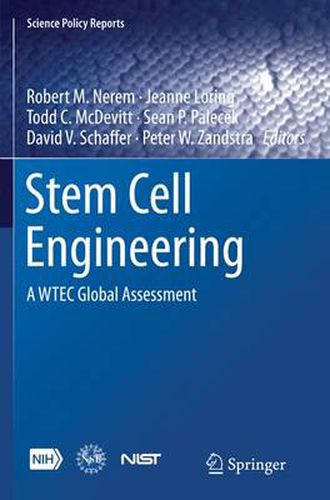Readings Newsletter
Become a Readings Member to make your shopping experience even easier.
Sign in or sign up for free!
You’re not far away from qualifying for FREE standard shipping within Australia
You’ve qualified for FREE standard shipping within Australia
The cart is loading…






This title is printed to order. This book may have been self-published. If so, we cannot guarantee the quality of the content. In the main most books will have gone through the editing process however some may not. We therefore suggest that you be aware of this before ordering this book. If in doubt check either the author or publisher’s details as we are unable to accept any returns unless they are faulty. Please contact us if you have any questions.
This book describes a global assessment of stem cell engineering research, achieved through site visits by a panel of experts to leading institutes, followed by dedicated workshops. The assessment made clear that engineers and the engineering approach with its quantitative, system-based thinking can contribute much to the progress of stem cell research and development. The increased need for complex computational models and new, innovative technologies, such as high-throughput screening techniques, organ-on-a-chip models and in vitro tumor models require an increasing involvement of engineers and physical scientists. Additionally, this book will show that although the US is still in a leadership position in stem cell engineering, Asian countries such as Japan, China and Korea, as well as European countries like the UK, Germany, Sweden and the Netherlands are rapidly expanding their investments in the field. Strategic partnerships between countries could lead to major advances of the field and scalable expansion and differentiation of stem cells. This study was funded by the National Science Foundation (NSF), the National Institutes of Health (NIH) and the National Institute of Standards and Technology (NIST).
$9.00 standard shipping within Australia
FREE standard shipping within Australia for orders over $100.00
Express & International shipping calculated at checkout
This title is printed to order. This book may have been self-published. If so, we cannot guarantee the quality of the content. In the main most books will have gone through the editing process however some may not. We therefore suggest that you be aware of this before ordering this book. If in doubt check either the author or publisher’s details as we are unable to accept any returns unless they are faulty. Please contact us if you have any questions.
This book describes a global assessment of stem cell engineering research, achieved through site visits by a panel of experts to leading institutes, followed by dedicated workshops. The assessment made clear that engineers and the engineering approach with its quantitative, system-based thinking can contribute much to the progress of stem cell research and development. The increased need for complex computational models and new, innovative technologies, such as high-throughput screening techniques, organ-on-a-chip models and in vitro tumor models require an increasing involvement of engineers and physical scientists. Additionally, this book will show that although the US is still in a leadership position in stem cell engineering, Asian countries such as Japan, China and Korea, as well as European countries like the UK, Germany, Sweden and the Netherlands are rapidly expanding their investments in the field. Strategic partnerships between countries could lead to major advances of the field and scalable expansion and differentiation of stem cells. This study was funded by the National Science Foundation (NSF), the National Institutes of Health (NIH) and the National Institute of Standards and Technology (NIST).